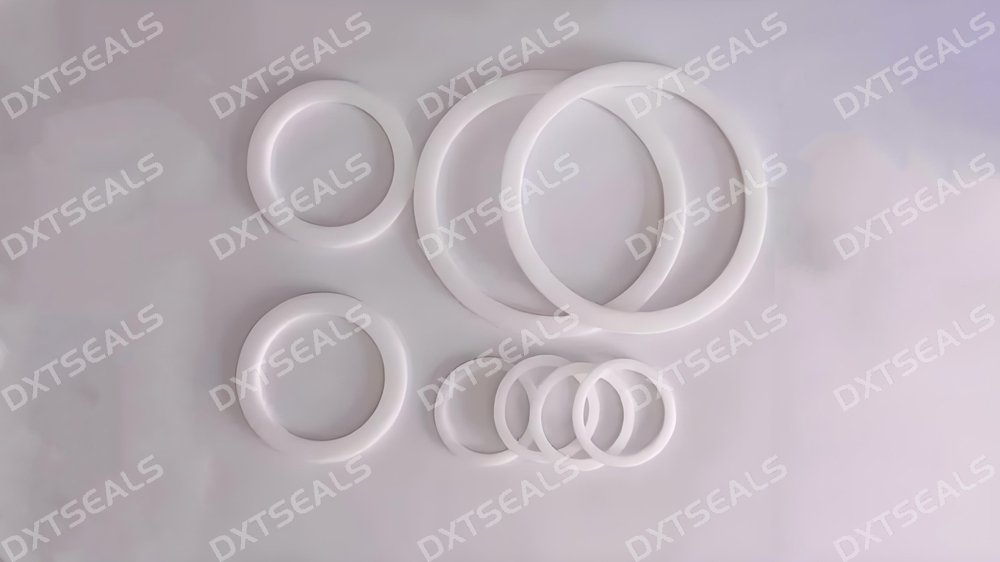
When selecting sealing components for industrial applications, the working medium—whether it’s water, oil, gas, or chemicals—is one of the most critical factors influencing material choice.
Using the wrong seal material can lead to swelling, cracking, leakage, or even complete system failure. This guide from DXTSEALS provides practical advice and a comparison table to help you choose the right sealing material for your media.
🧪 Why Working Media Matters in Seal Selection
The chemical compatibility between the sealing material and the working medium directly affects:
-
Seal life and integrity
-
Resistance to swelling, corrosion, and degradation
-
Leakage performance and pressure stability
-
Safety in extreme temperatures and pressure conditions
🧾 Practical Seal Material vs. Working Media Comparison Table
| Working Medium | Recommended Seal Materials | Remarks |
|---|---|---|
| Water (Cold/Hot) | EPDM, NBR, FKM | EPDM preferred for hot water |
| Hydraulic Oil | NBR, FKM, HNBR | FKM for high temp/oil resistance |
| Mineral Oil | NBR, FKM | Avoid EPDM (swells in oil) |
| Engine/Transmission Oil | FKM, ACM, PTFE | PTFE for long service life |
| Steam | EPDM, FFKM | EPDM for low-temp steam, FFKM for high-temp |
| Gasoline/Diesel | FKM, NBR (limited) | FKM preferred for fuel systems |
| Refrigerants | HNBR, FKM, CR | Check specific refrigerant type |
| Brake Fluids (Glycol-based) | EPDM | Avoid NBR, FKM |
| Alcohols (Ethanol, Methanol) | EPDM, FFKM | EPDM performs well in alcohol |
| Acids/Alkalis | PTFE, FFKM, EPDM | Use chemical resistance chart |
| Food & Beverage | Silicone, EPDM (FDA grade), PTFE | FDA/NSF compliant materials required |
| Natural Gas | FKM, PTFE | High chemical stability needed |
🧠 Key Factors to Consider Besides Media Type
Choosing a seal material isn’t just about media compatibility. Also consider:
-
Temperature Range
-
Can the material tolerate the working temperature without hardening or softening?
-
-
Pressure Level
-
Is the seal material mechanically strong enough for the application?
-
-
Friction & Wear Resistance
-
Particularly important in dynamic applications like pumps and valves.
-
-
Regulatory Compliance
-
For medical, food, or drinking water applications, certification is critical.
-
-
Cost & Availability
-
Some high-performance materials (like FFKM) are expensive and used only when essential.
-
📚 Common Rubber Materials Overview
| Material | Strengths | Limitations |
|---|---|---|
| NBR | Oil resistance, low cost | Poor ozone/UV resistance |
| EPDM | Excellent for water, steam, weather | Not oil/fuel resistant |
| FKM (Viton®) | Outstanding chemical & heat resistance | High cost |
| HNBR | Good for oil, heat, dynamic sealing | Costlier than NBR |
| Silicone | Wide temp range, FDA compliant | Low mechanical strength |
| PTFE | Chemically inert, low friction | Not elastic, needs support |
| FFKM | Extreme chemical & heat resistance | Very expensive |
✅ Seal Material Selection Tips
-
Use compatibility charts before making any final decision.
-
Test seals in actual or simulated working environments where possible.
-
Consult with experts (like DXTSEALS) for high-risk or regulated applications.
🧭 Final Thoughts
Choosing the right seal material for your specific working medium is critical to ensuring safety, longevity, and reliability of your equipment. While general guidelines help, practical experience and media-specific data are key to optimal performance.
If you're unsure, let DXTSEALS help you analyze your working conditions and recommend the best sealing solution.
📩 Contact DXTSEALS today for expert support and customized sealing solutions!
